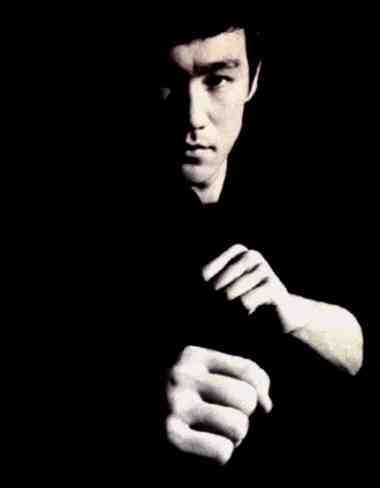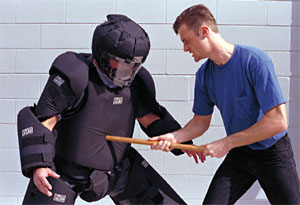Academy of Jeet Kune Do Fighting Technology
Athens
Greece
Jun Fan Jeet Kune Do Instructor
Vagelis Zorbas


Stick & Blade
 The
Philippine fighting arts are all about efficiency. When a skilled
practitioner swings a stick, he strives to eliminate all unnecessary
movement as he executes fluid offensive and defensive combinations. When
he wields an edged weapon, he endeavors to apply the same principles he
learned for the stick, and if they don’t transfer directly, he’ll
alter them bit by bit until they do.
The
Philippine fighting arts are all about efficiency. When a skilled
practitioner swings a stick, he strives to eliminate all unnecessary
movement as he executes fluid offensive and defensive combinations. When
he wields an edged weapon, he endeavors to apply the same principles he
learned for the stick, and if they don’t transfer directly, he’ll
alter them bit by bit until they do.
Not surprisingly, many arnis stylists believe you should practice with a stick the same way you train with a knife or sword. Although that’s not possible 100 percent of the time, the best training tips and action principles pertain to both facets of the art. The following nine morsels of advice fall into that category of crossover application. They’re sure to supercharge the effectiveness of your stick and knife skills.
Keep Your Knuckles Facing Forward
When you hold a knife or sword using a standard grip, the blade faces
outward from the front of your fist. Therefore, when you’re using a
stick, you should hit with the "front" of it as well. The
benefits are twofold: It helps you develop edge awareness, and it
encourages you to use a grip that will transfer the force of a blow into
your palm and not against your thumb and fingers, thus reducing the chance
that you’ll drop the weapon. Bad habit: In competition, practitioners
frequently execute fanning strikes with their sticks. Such techniques can
be fast, but if they become habitual and you try them with a sword, you
won’t hit with the edge of the weapon. Although the resulting strike
with the flat portion of the blade can be used as a parry or a distraction
before a follow-up slash, it has limited usefulness.
Don’t Grab the Stick
 In
most weapons-based systems, the "alive hand"—the one not
holding the weapon—plays an important role. Some practitioners even
insist that skill with the alive hand is as important as skill with
the weapon. As you focus on maximizing the potential of your alive hand in
combat, avoid using it to grab your opponent’s stick. Use that technique
against an opponent armed with a blade and you’ll immediately know why.
In
most weapons-based systems, the "alive hand"—the one not
holding the weapon—plays an important role. Some practitioners even
insist that skill with the alive hand is as important as skill with
the weapon. As you focus on maximizing the potential of your alive hand in
combat, avoid using it to grab your opponent’s stick. Use that technique
against an opponent armed with a blade and you’ll immediately know why.
That advice also pertains to the "stick wrap" and "snake disarm." While those techniques can be effective for trapping or disarming an opponent who has a blunt weapon, if he’s holding a real blade, all he has to do is move it around a bit and you’ll be cut to ribbons. If you must use a wrap or snake disarm, do it on his arm. Then get a joint lock on the entangled limb or hold it long enough to land a few strikes. The exception: When you must defend against a sword or machete being thrust at you, it’s sometimes advisable to slap the blade. That’s because if you reach for his hand, the point of his weapon might penetrate your body. Furthermore, if you parry the blade, you have a 50/50 chance of slapping one of its flat sides. Even if you lose that gamble and get cut, it probably won’t be that serious unless you have a close encounter with the point.
Don’t Always Train for a Duel
 Most
of the sumbrada flow drills taught in the Philippine arts are designed to
build your skills and accustom you to combative movement. To ensure that
you don’t restrict your own growth, occasionally forgo the stick-vs.-stick
and hand-vs.-hand duels in favor of mixed combinations. Try using a knife
against your partner’s stick. In no time you’ll become more aware of
your body and learn just how universal movements can be.
Most
of the sumbrada flow drills taught in the Philippine arts are designed to
build your skills and accustom you to combative movement. To ensure that
you don’t restrict your own growth, occasionally forgo the stick-vs.-stick
and hand-vs.-hand duels in favor of mixed combinations. Try using a knife
against your partner’s stick. In no time you’ll become more aware of
your body and learn just how universal movements can be.
Fringe benefit: You can also apply this concept to sparring. Try using a stick to fend off your partner’s continuous knife attacks, then ditch it and go with your empty hands. Of course, you’ll need to approach this exercise in a careful and controlled manner, but once you do, you’ll realize how dangerous weapons truly are and that an armed opponent should be confronted only if you have no alternative.
Go Empty Hand Against Street Weapons
Defending against weapons is one of the most important facets of the
martial arts. The reason is simple: Modern laws often prohibit good guys
like you from carrying a weapon—the bad guys, of course, don’t obey
the law—and even if you do have one in your pocket, there’s no
guarantee you’ll be able to access it in time.
 Therefore,
you should concentrate on developing your street smarts with respect to
weapons defense, and the best time to do that is during training. With
only your empty hands, face off against an opponent who may or may not be
armed. Make a conscious effort to keep your eyes on his hands. If he keeps
them out of view, he may be hiding a weapon and preparing to surprise you
with it. Your awareness and your empty-hand counterweapon skills are what
will keep you alive. Back up your plan with techniques for controlling and
disarming an opponent.
Therefore,
you should concentrate on developing your street smarts with respect to
weapons defense, and the best time to do that is during training. With
only your empty hands, face off against an opponent who may or may not be
armed. Make a conscious effort to keep your eyes on his hands. If he keeps
them out of view, he may be hiding a weapon and preparing to surprise you
with it. Your awareness and your empty-hand counterweapon skills are what
will keep you alive. Back up your plan with techniques for controlling and
disarming an opponent.
Best philosophy: Surprise your enemy by making your defense less of a reaction and more of an ambush
Don’t Make Grappling Your Main Strategy
Because knife assaults often start at close range, you should know how to
grapple with an armed adversary, but remember that grappling with edged
weapons is not like grappling in competition. If someone has a knife, once
you close the distance, it’ll be over in seconds—usually with one or
both of you severely injured. Long-range goal: As you train against knife
and stick attacks, strive to maintain the distance between yourself and
your opponent as you strike at him. Aim to inflict cumulative damage. If
he’s overly aggressive, however, be ready to fall back on your
close-range-combat and grappling skills. If you’re unarmed, you most
likely will have to grapple. Stay out of range long enough to distract
him, then quickly close the gap. Your first goal is to control and
neutralize the weapon, then the opponent.
Use the Witik and Abanico Strategically
 The
witik is a quick snapping motion also known as the snap cut. It’s used
at long range to cause cumulative damage and psychologically unbalance an
opponent—often as a counter-cut. A snap cut to the hand done with a
heavy, sharp blade can cause serious damage. One delivered to the inside
of the wrist can take the appendage out of commission. That effectiveness
comes with a price, however, for it will often leave you open to a
counter.
The
witik is a quick snapping motion also known as the snap cut. It’s used
at long range to cause cumulative damage and psychologically unbalance an
opponent—often as a counter-cut. A snap cut to the hand done with a
heavy, sharp blade can cause serious damage. One delivered to the inside
of the wrist can take the appendage out of commission. That effectiveness
comes with a price, however, for it will often leave you open to a
counter.
The abanico is similar to the snap cut but uses a quick fanning motion that doesn’t always strike with the edge of the weapon. Although it’s weaker, it offers the advantage of speed. It may not always inflict a great amount of damage, but it can protect you while it opens your adversary for a more telling blow.
Tournament caveat: The abanico is frequently seen in competition as two martial artists stand toe-to-toe and fan each other’s heads, but if that were attempted in combat, both fighters would be in big trouble. Remember that protective equipment and the drive to score more often than your opponent can lead to risky tactics that would get you killed in a real knife fight.
Train the Thrusting Lines
 A
popular adage in the knife world is, slashes injure while thrusts kill.
It’s widely believed that 80 percent of the knife attacks that occur on
the street are slashes but most kills are effected with multiple stabs.
Obviously, it behooves you to learn how to defend against slashing motions
but not at the expense of the time you devote to countering deadly
thrusts.
A
popular adage in the knife world is, slashes injure while thrusts kill.
It’s widely believed that 80 percent of the knife attacks that occur on
the street are slashes but most kills are effected with multiple stabs.
Obviously, it behooves you to learn how to defend against slashing motions
but not at the expense of the time you devote to countering deadly
thrusts.
Corroborating quote: English sword master George Silver once said the art of the sword relies on both the cut and the thrust, but in single combat the thrusting rapier is considered king.
Use Slicing Motions
When practicing your slashes, don’t let tunnel vision make you do only
full-power strokes. Although they’re fine techniques that have their
place in combat, you must also hone your drawing and slicing skills. When
your weapon hits its target, pull it back toward your body while it’s
still in contact with your opponent. That will maximize the pain inflicted
by a blunt object and the depth of the cut inflicted by a blade. Plain
English: Sometimes sawing through a tree trunk is better than chopping at
it.
Never Think You Can Predict Combat
Fighting is fluid and chaotic. Your opponent won’t just stand still and
let you poke and slash at him. Therefore, no matter whether you’re
wielding a stick or a blade, you shouldn’t be totally confident every
technique will work.
The best way to prepare yourself for all the uncertainties of fighting is to work on drills that teach principles. That way, you’ll learn movement instead of moves. Among the most beneficial methods are flow drills, free-flow sessions, sparring, full-contact tire and target striking, and controlled freestyle training against multiple opponents. Metaphysical leap: You’ll learn to embrace chaos in training so you can face chaos in battle.
